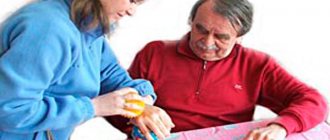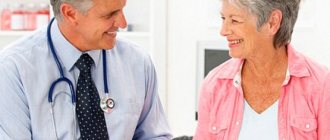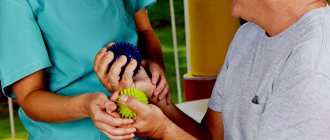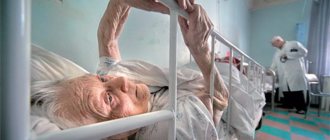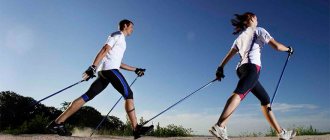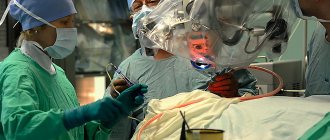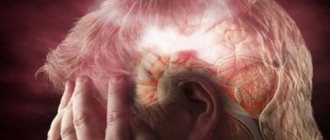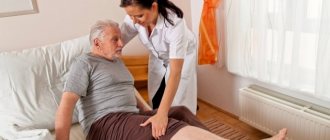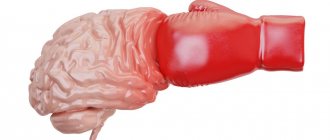Features of training rehabilitation
When a person has a stroke, cerebral circulation is disrupted, leading to serious impairment of motor ability.
Common consequences include joint contracture, muscle atrophy and spasticity, paresis and paralysis.
The brain loses the ability to coordinate and control joints and muscles. Only special events can gradually restore lost functions.
The rehabilitation scheme is strictly individual, complex, the most important element of which is exercise therapy.
Special simulators provide mechanotherapy. Essentially, these are devices, instruments and appliances that provide targeted physical activity to the joints and muscle tissues affected by a stroke. They solve the following problems:
- Normalization of muscle tone. Post-stroke muscle hypertonicity impairs the activity and coordination of joint movement. Exercise machines allow you to restore normal muscle tone, achieve the desired sequence of movement, restore biological feedback and neuromuscular control, and eliminate pain during movement.
- Improving blood circulation and trophism. Controlled physical activity normalizes the supply of oxygen to brain tissue, normalizes tissue metabolism, which has a positive effect on the innervation of motor centers.
- Overcoming the psychological factor. After prolonged immobility, a person develops a psychological barrier, the fear of loss of mobility. He simply loses confidence in his abilities. Exercise machines allow the victim to again learn to control his muscles, walk, load his limbs, and hold objects in his hands.
Important! The advantage of simulators is the possibility of targeted loading of muscles and changing the point of application of the load, regulating the load and amplitude of movement. During the rehabilitation period, they help to gradually restore the relationship of the brain with the limbs and other muscular systems and restore physical fitness.
Walking aids
The most popular group of exercise equipment after a stroke is aimed at resuming walking. It is this lost skill that most disrupts the patient’s quality of life, since simply going to the kitchen or toilet becomes a big problem for him. For rehabilitation, special steppers are used. They consist of two flywheels with footrests and supports that the patient can hold on to during exercise.
Some models have additional replaceable handles. They change their shape (bend) or move to simultaneously work on the shoulder girdle. The package includes pulse meters for dosing loads. The advantages of gait training simulators are:
- effective activation of lost functions;
- acceleration of peripheral and systemic circulation;
- preventing muscle atrophy;
- normalization of body weight;
- restoration of coordination of movements.
A simulator for restoring walking at home
The next variety is a step platform. It looks like a step or several (like a low staircase). You need to step on them with your feet alternately, while holding onto a strong support. It is best if it is a specially reinforced crossbar or handle.
At the same time, simulators cope with this task faster, but even without their use you can achieve excellent results if you do gymnastics and massage purposefully and with enthusiasm.
All loads must be feasible, exercises are performed only at a comfortable level, with a gradual increase in the duration and intensity of training. When mood and desire to exercise decrease, psychological help is required; sometimes patients are prescribed medication (antidepressants, psychostimulants) to correct apathy and depression.
And here is more information about restoring speech after a stroke.
The recovery period after a stroke includes daily therapeutic exercises. To speed up the resumption of active movements in the fingers, hand, and entire arm, exercise machines with a mechanical engine or improvised devices are used.
The joints and large muscle groups of the lower limb are developed using an exercise bike. Steppers help restore lost walking function. Good results are achieved only with daily exercise.
Varieties
Simulators for post-stroke rehabilitation can be divided into several categories:
- Place of installation and operation. There are 2 varieties - for home use and for specialized rehabilitation institutions. In the first case, the devices are small in size and simple in design;
- Design features - specialized and adaptable simulators. The first group includes devices specially designed for patients with impaired motor function. Various devices and objects that have a different purpose can be used as adaptable simulators. Examples include balls, foot supports, regular sticks, wall bars, etc.;
- The direction of impact is local devices and general impact simulators. Among the local devices there are simulators for hands, feet, fingers, etc. When using devices of the second type, several muscle groups are loaded at once (exercise bikes, treadmill, etc.).
It is best to purchase rehabilitation exercise equipment ready-made, in specialized stores. They are accompanied by instructions that will help you organize the operation correctly.
Important! Simple exercise machines can be made with your own hands, which helps to rationally place them in the apartment.
Exercise bikes
An exercise bike is a device with sadness that simulates riding a bicycle.
This simulator puts stress on the lower limbs, which helps restore walking skills.
Training on an exercise bike is carried out in a sitting position, which ensures simultaneous loading of the muscles of the legs and back, helping to reduce restrictions on the mobility of the torso, restoring not only the legs, but partly the arms.
There are 2 types of exercise bikes - with forced and natural rotation of the pedals. The first option is typical for use in a medical hospital. The feet are fixed on pedals, which are forced to rotate at a given speed. The lower limbs are forced to repeat the movement of the pedals.
Reference! Exercise bikes have been used since the first days of rehabilitation after a stroke.
At home, to restore the motor abilities of the legs, you can use a simpler exercise bike, on which the person himself pedals. The load is changed by adjusting the resistance to rotation, and its frequency is set by the participant in the lesson. In most cases, positive results from using an exercise bike are observed after 5-7 weeks of regular training.
For hands
With a stroke, the upper extremities are often affected. Special and adaptable exercise machines help eliminate muscle atrophy, restore fibers and normalize innervation, and restore hand function. The following types of simulators for developing arms are distinguished:
- universal static devices for developing fingers, hands and forearms;
- complex simulators for simultaneous loading of arms and legs;
- devices with biological feedback and computer control;
- dynamic devices of pedal and lever type;
- robotic simulators.
For fingers
One of the most effective simulators of this type is the “Bud” device. It allows you to fix your fingers at different distances from the tips. The load when extending and bending the fingers can be adjusted.
Coordination of finger movements can be trained using the Busyboard set. It is a board on which you can perform simple operations with laces and balls.
Important! Rubik's cube, plasticine or clay, rubber balls and rings are great for restoring hand motor skills.
For the hand
Hand trainer “Machine”.
What will help restore hand mobility?
The upper limb can be developed using mechanical devices. They are levers similar to bicycle pedals, a ship's steering wheel, or crossbars attached to a spring.
At home, hand exercises are performed with an elastic bandage. It is tied into a ring and stretched with the hands, then the loop is placed at the level of the forearm, gradually moving higher and higher to the shoulder. You can even practice while lying in bed if you throw a bandage over the bar and take its ends in your hands.
Mechanical pedal exerciser for arms
The second device is a gymnastic stick. Its role can be anyone suitable in shape and smoothness. To perform the exercises, it is raised to shoulder level, behind the head, and intercepted with the hands in a vertical position. One of the simplest devices is the most common mechanical meat grinder or juicer with a handle.
Exercise equipment for rehabilitation and recovery after stroke
After an acute disturbance of cerebral blood flow, severe consequences almost always occur. A stroke threatens paralysis of the arms and legs, and patients’ movements are often limited. When microcirculatory processes are restored, the victim of stroke will have a long period of rehabilitation. To restore mobility, drug therapy, physiotherapy are used, and exercise equipment has been developed after a stroke. They are especially useful for normalizing muscle tone of the limbs, restoring nerve and muscle connections. Thanks to training on these mechanisms, movements will become coordinated.
When to start training
Intensive treatment for patients who have suffered stroke is carried out for at least 4-5 days. At this time, physical activity is contraindicated. Therapeutic and preventive measures, including simple gymnastics to develop the legs and fingers after a stroke, are carried out no earlier than 5-6 days later.
The beginning of the rehabilitation period depends on various circumstances. If the pathology is mild, rehabilitation begins after 8 or 10 days. Recovery with the help of simulators begins 14-17 days after stroke. First, the patient studies in the hospital, then at home.
On the first day, the patient is on a gentle regimen; a gradual increase in loads is necessary.
During the post-stroke period, recovery is recommended to be carried out with training devices that help develop the limbs; a specialist selects an individual recovery program.
Features of training rehabilitation
Common complications after stroke:
- joint contracture occurs;
- muscle tissue becomes spasmodic and atrophied;
- muscle strength decreases, motor function is limited due to neuronal damage (paresis);
- paralysis.
Mechanotherapy to restore finger mobility after a stroke is carried out using training devices. They help restore lost functions and provide physical stress to joints and muscles.

Mechanotherapy devices normalize the tone of muscle tissue, movements will become coordinated, joint function will improve, and pain during movements will be eliminated. Microcirculatory processes and nutrition of cerebral structures improve. The brain receives more oxygen, metabolism and innervation of motor centers improves.
After a long period of immobility, the patient will develop a psychological block; the person is afraid to remain motionless and becomes unsure of himself.
Thanks to medical simulators, the patient gains control over his myofibers, begins to move, loads his legs, and holds small objects with his hands.
Reviews
Nikolai, Moscow
“We ordered a simulator from you in January 2020. We watched the video on the disk, your instructor was so clever at teaching you. We doubted whether we could do the same, but we started classes. And here, at my husband's …
the arm rose a little, in a lying position! And before that, I didn’t move at all for 9 months! We looked at it with tears in our eyes! So, after all, the thing is effective. Now we are planning to order a platform for his feet so that he can walk better. »
Ukhanova Vera Konstantinovna, Vyksa
“A neurologist friend from a rehabilitation center advised me to order the Wave Doctor simulators. In July, they brought me a stick trainer, a footrest, and a seat. In 4 months I quit …
La walker, learned to walk on her own, with the help of a cane. My high blood pressure has leveled off to normal. Recently I asked instructor Ilya to conduct classes with me. In 2 hours we were able to relax our hand. The hand that was always cold and I was holding it in a glove became hot. The main thing is that after training with the simulator, I understood the difference between “squeeze your fingers” and “move your fingers.” »
Elena Mikhailovna, Korolev, Moscow. region
“Anton suffered a stroke after a motorcycle accident. I was in a coma for 9 days, then 5 months of exercise therapy. I began to walk quite well, but my hand did not want to obey. The fingers curled up and did not move. …
From the elbow and below - very bad, spasticity, no movement. We ordered the Wave Doctor simulator for the arm. As soon as Anton took the exercise machine in his good hand, he said “Cool!” Then Alina, who brought the exercise machine, showed passive gymnastics, and he began to feel his fingers! Then the elbow joint fully straightened, the thumb began to move slightly, Anton began to smile, doing the exercises shown with pleasure. At the end of the first lesson (!) he already bent his arm at the elbow, his hand relaxed, without spasticity. Anton turned pink and cheered up. But 2 days ago he was depressed, and now he is so motivated to recover! »
Anton's mother, Moscow, South Butovo.
"Good evening! This is the second time I have ordered a trainer. At first I took the “Universal” simulator to help our dad develop his arm after a stroke. Now we have ordered a footrest, by a transport company with delivery …
right up to the door. Thank you for your troubles! Everything is ok, I received the goods. God bless you! Thanks a lot! »
“Trouble happened to me in September 2013; my left side was paralyzed. He began to walk poorly, and his arm was completely immobilized, hanging like a whip. In November 2013, I learned about the Agashina simulator and ordered …
and we are a medium simulator for training arms and legs. The arm gradually began to move and I can lift it myself without help. Many thanks to the specialist who designed this simulator and to those who sent it. I work out every day. Now I can't do without it. »
Sokolov Alexander, pensioner, Krasnoyarsk
“In the month that I have been working as a nurse for Alexander (and I have been working as a nurse for a long time and have seen many) - this is simply gigantic progress! And, I can say, no massage can compare with this simulator...”
Laura, nurse of a stroke survivor, Moscow.
“I want to say that we were very struck by the dramatic changes that occurred with Andrei’s hand. When you give him the command: “Andrey, raise your hand!”, which did not rise at all, did not obey. And he goes …
said: “I can’t.” And so, with tension, he takes it, and to the level of his chest, so, and he himself does not believe either his eyes or his sensations. It’s true, it’s a big shock, and it literally happened within a week, from the last lesson. Ilya showed us the exercises, and Andrey succeeded. And my daughter asked: “Dad, show us!” And he takes his hand with tension, and you can see how the thought goes from his head into his hand! Right in front of her eyes! And my daughter and son-in-law look and don’t believe their eyes. And before Andrey wouldn’t even let me touch his hand, it hurt. This is a miracle, of course! And he tries, and he succeeds. Thanks a lot! »
Larisa Kh., wife of a stroke survivor, Moscow
“We watched your technique, watched the video on the website, and decided to try it with a regular stick. They shook the hand and it relaxed a little. We realized that this technique is effective, we decided …
order exercise equipment. And, of course, it’s even more fun and interesting to work out with them :)) Please post on your website even more videos of the results of people who have recovered with the simulator, with their stories and dates! »
Kitaev family, 52 years old, 3 years after stroke, frequent. paralysis, hand spasticity., Moscow
Leave feedback
All reviews (29)
- Conscious training of the extensor muscles of the palm and fingers in tension-relaxation mode
- Improves mobility of elbow and shoulder joints
- Improves coordination and increases range of arm movements
- Improves blood circulation
- Prevention of contacture
Price: 9900 rub.
ORDER
Purpose
The “Machine” simulator is intended for:
- conscious training of the extensor muscles of the palm and fingers in the tension-relaxation mode,
- improving mobility of the elbow and shoulder joints.
- Improves coordination and increases range of hand movements.
- Improves blood circulation.
The “Machine” simulator has inertial movement, unlike cubes, pyramids and other toys used to restore fine motor skills after a stroke.
Work on the simulator is carried out through conscious muscle efforts
, in contrast to simulators for passive development of the arm, for example, the “Bud” simulator.
Device
The “Machine” exercise machine consists of two working and one auxiliary plates, a spring mechanism, a stopper, four rollers and two Velcro fasteners for the hand (palm) and forearm. All plates are connected to each other using hinges. Two rollers are located coaxially on the working plates.
Rollers ensure the rolling of the exercise machine along the supporting surface of the table. Working plates are designed to set the fingers and palm into working position. The auxiliary plate is designed to fix the forearm. Velcro fasteners secure the palm and forearm.
A spring mechanism fixed between the working plates prevents the opening of the hand in the initial position, and when pressed, it resists the opening of the palm and engages the muscles of the forearm, which are responsible for opening the palm. The simulator is ergonomic - different hand sizes are taken into account.
At the maximum opening of the palm, the working surfaces rest against a stopper, which prevents the palm from over-opening.
The range of changes in the opening angle is from 90 to 180 degrees.
Inertial movement is only possible when the extensor muscles are activated, otherwise the machine will not move (if you do not press lightly on the machine, it will not be able to move along the surface).
Pressing on the exercise machine can be done with the injured, healthy, and both hands.
Exercises
The “Machine” simulator must be used:
With a healthy hand, . arm paralyzed after a stroke. with both hands (the healthy one helps the patient move).
The hand is placed in the exercise machine and secured with Velcro fasteners. The palm should fit snugly against the surface of the work plate.
The simulator is placed on a flat horizontal surface (table), palm down, on four support wheels. In the future, as your skills improve, you can use a vertical surface (wall) for training.
A). The patient rhythmically presses with one or two hands on the working plates, trying to bring them into a position parallel to the supporting surface (achieve an angle of 180 degrees between them).
(!) It is important to consciously maintain the rhythm and amplitude, and gradually increase the number of repetitions.
B). The patient presses the machine, spreading the working plates to an angle of 180 degrees, and rolls the machine with one hand or two hands in different directions on a flat working surface (on a table, on a wall).
(!) It is important to learn to consciously choose the trajectory of movement. Control the speed and smoothness of movement. Achieve maximum amplitudes. As motor skills and coordination develop, it is important to complicate and diversify movement trajectories.
By practicing with a healthy hand, a motor skill is activated - the brain understands: “How it’s done.” The movement of the sore arm at the beginning of classes may be very weak, but the machine will begin to move and will put minimal stress on the extensors. When riding, it will drag your hand along with you, allowing conscious movement.
How to practice
Smirnova Olga Leonidovna
Neurologist, education: First Moscow State Medical University named after I.M. Sechenov. Work experience 20 years.
Articles written
Stroke is affecting more and more people. This figure is increasing every day. And the costs for such patients are very high. After all, here we are talking about drug support, treatment and special medical equipment. Let's figure out what simulators provide for, and how effective they are.
Types of exercise equipment after a stroke
Various recovery machines help normalize the mobility of arms and legs after a stroke.
Mechanotherapeutic
These devices are needed to develop muscle and joint tissues of the legs and arms, the functionality of which has been partially lost. A mechanotherapeutic simulator after a stroke functions thanks to the work of the patient’s muscles; some devices are equipped with electric motors so that the person’s movements are performed forcibly.
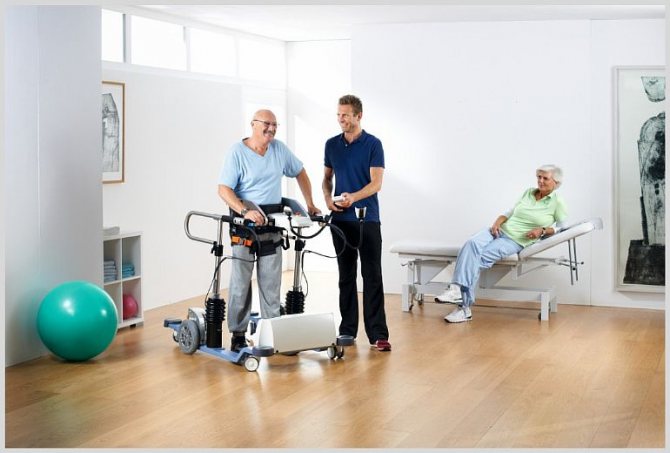
The following training mechanisms will help restore mobility to the patient:
- Bed-like exercise bikes that help passively develop limbs. Thanks to them, the arms and legs of an immobilized person will work again.
- In the form of a seat. A victim of stroke will be able to get up and sit on a chair.
- Similar to the platform required for walking.
There are also devices that help develop joints. Thanks to these mechanisms, the patient’s limbs will bend, straighten, and rotate better.
Myostimulators
Designs for fingers and toes that apply electrical stimulation to superficially and deeply located myofibers are called myostimulators. The myostimulating exercise machine for recovery helps to get rid of pain, eliminate muscle spasms, it is indispensable for people with disabilities after a stroke.
Electrical stimulation of muscle tissue is provided by electrodes placed on the forearm. Microcurrent (2.5-5 mA) is alternately supplied to the radial, ulnar, and median nerves. The session lasts from 6 to 9 minutes.
On the leg, electrodes are attached in the area where the peroneal and tibial nerves pass. The procedure is daily, the course of treatment ranges from 11 to 15 days.
Robotic mechanisms

These devices are programmed for specific commands; the simulator for the arm and leg after a stroke has sensors that interact with brain neurons and peripheral nerves. The device for the legs and arms imitates an immovable limb, which will move thanks to a sensor that supplies impulses through the cerebral structures. Then the limb makes movements in the specified direction, the parameters of these movements are programmed.
Robotic mechanisms will help replace a physical therapist in an outpatient setting. Observing the operation of the device, the patient strives to learn to move again and make independent movements with his hands.
Alternative options
To train the muscles, joints of the arms and legs every day for the rehabilitation of a patient after a stroke at home, you need to work with:
- expanders;
- small dumbbells;
- a gymnastics stick;
- spiked ball;
- glove-shaped clamps for straightening fingers;
- devices that help develop grasping movements and improve coordination;
- devices for the development of fine motor skills.
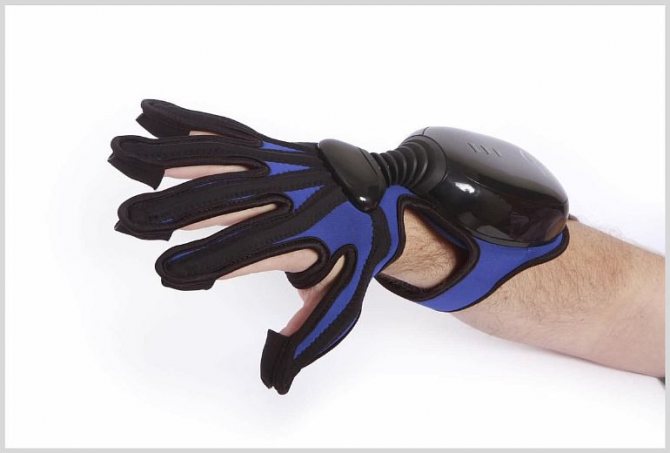
A horizontal bar, hoop and jump rope will also help the patient. The legs at home are well developed with a step platform that imitates movements on the stairs, strengthening the ankles and knees. On this simulator, the legs step in turn, the patient needs to hold on to the support.
Training for accelerated rehabilitation should be carried out regularly.
At home, you can develop your arm using an elastic bandage. It is tied to form a loop. They perform stretches with the hands, and also train the forearm and shoulder areas. Even in a supine position, the bandage is thrown over a tripod, the ends of the stretching machine are taken with your hands and exercised.
The gymnastic stick for developing arms should be raised to the shoulder area, behind the head, and interceptions are performed in a vertical position.
TOP exercise equipment after a stroke
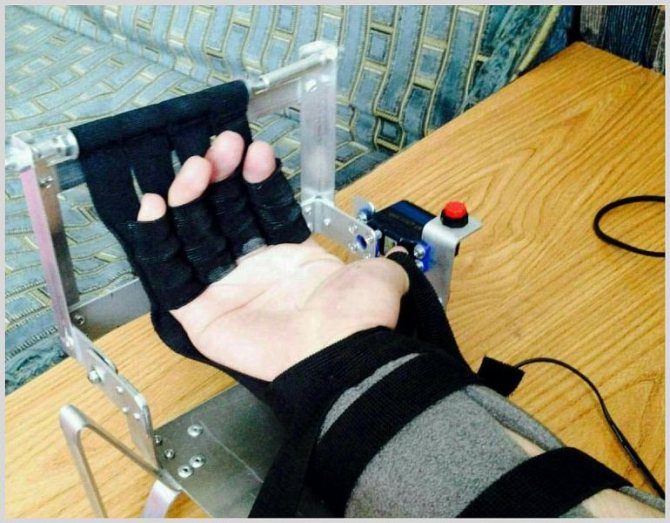
| The “Bud” hand simulator, similar to a mitten fixed to a base, will help restore the function of the fingers of the upper extremities. | Exercises with it will help restore flexion and extension. Each finger is in a clamp, the palm is attached to the base using straps. The device operates thanks to an electric motor; the fingers will be developed passively in walking and bedridden patients. The extension angle and speed are programmed by a specialist individually for each patient. |
| Rehabilitation of motor activity in a bedridden patient occurs faster with the Shagonog walking simulator. | Thanks to this device, the muscle tissue of the patient’s legs functions as during normal walking and will not atrophy. The simulator is equipped with a power supply, a special support, and a comfortable footrest. Before starting classes, the leg is secured with clasps. |
| The MOTOmed viva 2 device will help to work out the microfibers of the limbs. | Thanks to it, a person’s spasticity will decrease, pain in the lower extremities will disappear, walking will improve, and joints will become more mobile. An active training mode is available when the myofibers are partially restored. Passive mode is carried out using an electric motor that drives the pedals. Intuitive control is provided thanks to the color display; the buttons for the probable step are green on the screen. Slightly convex enlarged keys and a large picture on the display will make it easy to control this smart mechanism. The device is equipped with useful functions:
At the end of training on this simulator, an evaluation of the results is available, which indicates time, distance, symmetry and other training parameters. |
| The Manuped device will help to rehabilitate the motor functions of the arms and legs. | It is possible to adjust the individual load for the patient. On the support of the device there are handles on top, and pedals on the bottom, which are attached to the feet with straps. The counter allows you to measure the revolutions performed by the pedals. Screw load adjustment available. The mobile steering wheel will allow patients of different heights to use the simulator, and the synchronization of rotational movements can be adjusted. The simulator is suitable for atrophied, hypertrophied, and partially paralyzed muscles. |
During training, the patient should be under the supervision of a specialist.
Thanks to exercise therapy and training on exercise devices, the patient’s rehabilitation will speed up and their well-being will improve. Before purchasing a simulator, you should consult with your doctor, he will select an individual training program.
